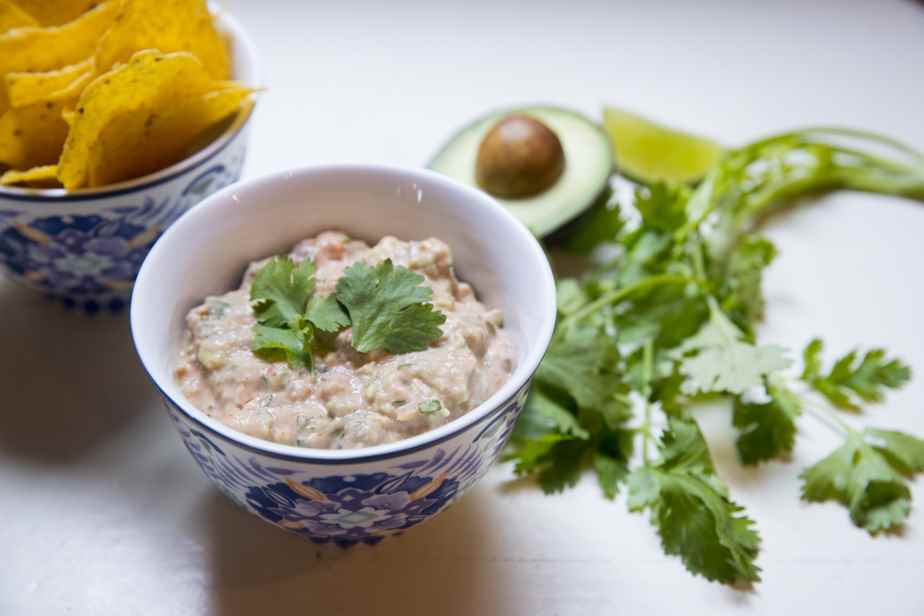Just before the weekend, all readers who cook ask themselves this eternal question: what are we going to eat? In order to inspire you, The Press suggests some suggestions for seasonal recipes that will make your mouth water.
Posted at 11:00 a.m.
Indulgence: Vietnamese coriander guacamole
As its name suggests, Vietnamese coriander can be grown in Quebec. “It is possible to replace the Vietnamese coriander with the usual coriander, indicates Hélène Baril, author of the recipe published in Fine herbs and edible flowers from Quebec, published by Broquet. But it will be necessary to add a large tablespoon of the latter, because the taste of Vietnamese coriander is more pronounced. »
Ingredients
- 2 ripe avocados
- 300 ml homemade or store-bought salsa
- 3 or 4 tbsp. sour cream
- 2 tbsp. finely chopped Vietnamese cilantro
- 1 C. finely chopped fresh mint
- 2 or 3 drops of Tabasco sauce
Preparation
- 1. In a mixing bowl, coarsely mash the avocados with a fork.
- 2. Stir in salsa and sour cream. Mix well.
- 3. Add herbs and Tabasco.
- 4. Serve immediately, accompanied by corn tortillas.
Source : Fine herbs and edible flowers from Quebec. Helen Barrel. Broquet Editions.
Posted in The Press+ on August 3, 2017.
Quickly Done Well Done: Cauliflower and Cheese Pizza
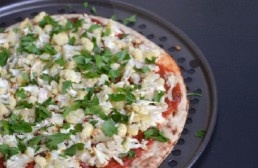
Photo Sophie Ducharme, special collaboration
Cauliflower and Cheese Pizza
Quebec cauliflowers are very affordable during harvest time. With seasoned cream cheese, like the famous Boursin, it’s delicious and a change from the traditional mozzarella on pizzas. You can vary the herbs and even add more greens (arugula, microgreens, etc.).
Ingredients for 4 persons)
- 1 small cauliflower, in small florets
- A drizzle of olive oil
- 1/4 cup parmesan cheese, grated
- 1 store-bought whole-wheat pizza crust about 11 inches in diameter
- Pizza sauce or tomato sauce, to taste
- A 150 g container of Boursin-type pepper cheese
- Flat-leaf parsley, to taste
- Salt and pepper
Preparation
- 1. Preheat the oven to 400°C and line a baking sheet with parchment paper.
- 2. In a large bowl, toss the cauliflower florets with the oil and Parmesan. Season well and bake on the baking sheet for about fifteen minutes, or until the cauliflowers are tender. To book.
- 3. Place the crust on a pizza pan and spread the sauce on it. Arrange the cheese evenly over the sauce, in small amounts of about 1-2 tbsp. then add the cauliflower. Bake for ten minutes.
- 4. Leave to cool for a few minutes and serve with the flat-leaf parsley.
Posted in The Press+ on August 31, 2017.
Call me boss! : osso buco and pork meatballs
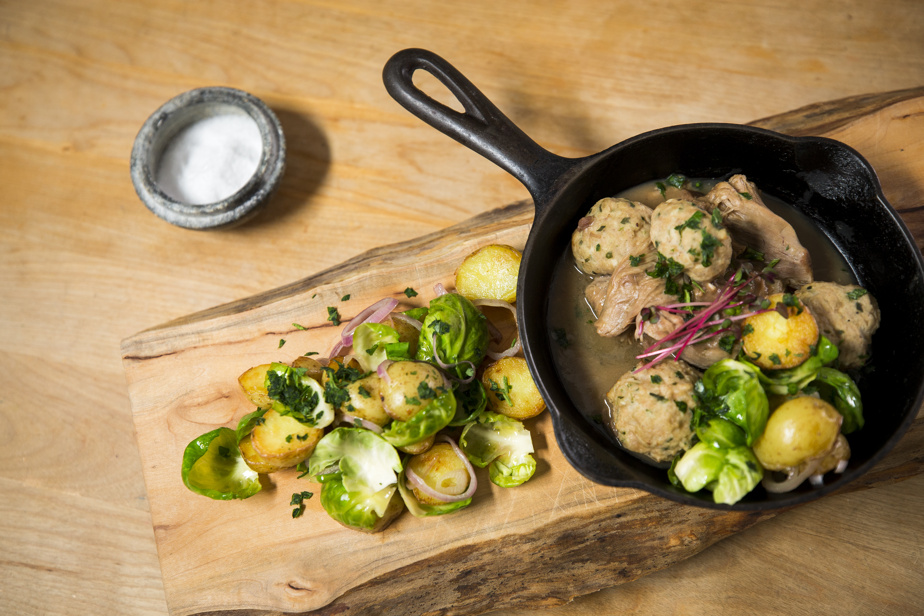
PHOTO OLIVIER PONTBRIAND, LA PRESSE archives.
Osso buco and pork meatballs
Here is a recipe to cook sous vide, a method that keeps the flavors and allows you to make it in advance. In this type of cooking, the seasonings are dosed to a minimum, because vacuum cooking concentrates the flavors.
For 8 people
Step 1: vacuum-packed pork knuckle slices
Prepared in advance, the cooking broth will be used for cooking the meatballs and the sauce.
Ingredients
- 6 slices of pork knuckle (osso buco cut)
- 2 tbsp. canola oil
- 2 yellow onions sliced
- 2 tbsp. minced garlic
- 1/8 tsp salt
- 5-8 pink peppercorns
- 1 star anise
- 1 clove
- 1 allspice seed
- 1/4 cinnamon stick
- 1 C. cider vinegar
- 200ml meat stock
- 2 sous vide bags (or thick Ziploc)
- 1 immersion heater (or a cooking thermometer)
Preparation
- 1. In a saucepan, pour the canola oil. Over medium heat, sear the six slices of pork knuckle on each side, then insert them into the two vacuum bags.
- 2. Add sliced onions to pan, brown, then add garlic, salt and spices.
- 3. Deglaze with the vinegar, pour in the broth, scrape the bottom of the pan well, reduce by half, add the ingredients to each vacuum bag, seal.
- 4. Place these in the basin of water with a stirrer and immersion heater, bring the temperature to 85°C, cook for 8 hours (or here is a method without an immersion heater: fill a large saucepan with water, attach a thermometer, hold the temperature at 85°C for 8 h).
- 5. When the time is up, immerse the bags in a container of ice water for 30 minutes.
- 6. Remove the pork knuckle slices, strain the broth through a colander, refrigerate.
- 7. Recover the pieces of pork flesh, set aside in another container, refrigerate.
Step 2: the dumplings
Makes 24 meatballs
Ingredients
- 500g minced lean pork
- 1 French shallot or 1 small onion, finely chopped
- 1 C. minced garlic
- 1 C. parsley
- 1/4 tsp. dry mustard
- 1/8 sec c. ground allspice
- 1/2 tsp. salt
- 1 egg
- 30ml milk
- 2 tbsp. breadcrumbs
- 4 tbsp. tablespoons (60 ml) defatted broth recovered from cooking the shanks (or other meat broth)
- 2 sous vide bags (or thick Ziploc)
- 1 immersion heater (or a cooking thermometer)
Preparation
- 1. In a bowl, place the milk and the egg, beat lightly with a fork, add the breadcrumbs and all the other ingredients except the pork, mix. Leave to stand for 5 minutes, then stir in the ground pork.
- 2. Form 24 balls with oiled hands, set aside on a baking sheet lined with parchment paper.
- 3. Place the meatballs in two vacuum bags, add the broth.
- 4. Place these in the basin of water with a stirrer and immersion heater, bring the temperature to 85°C, cook for 3 hours (or here is a method without an immersion heater: fill a large saucepan with water, attach a thermometer, hold the temperature at 85°C for 3 h).
- 5. When the time is up, immerse the bags in a container of ice water for 30 minutes.
- 6. Remove the meatballs from the broth, set aside in the fridge, pass the broth through a sieve, refrigerate.
Step 3: the stew sauce
Ingredients
- Broth of pork shanks and meatballs, defatted.
- 2 tbsp. cornstarch dissolved in 2 tbsp. tablespoon cold water
Preparation
- 1. In a saucepan, pour the broth, bring to the boil, and thicken by pouring in and gently whisking the cornstarch mixed with the water, reduce the heat and simmer for 2 minutes, adjust the seasoning if necessary.
- 2. Add meatballs and meat from the shanks, simmer for a few minutes to combine the flavors.
Accompaniments
- A stir-fry of baby potatoes
- Brussels sprout leaves
Source: Emmanuel Desjardins
Published on lapresse.ca on December 11, 2017.
Guilty Pleasure: Potato and Maple Syrup Donuts
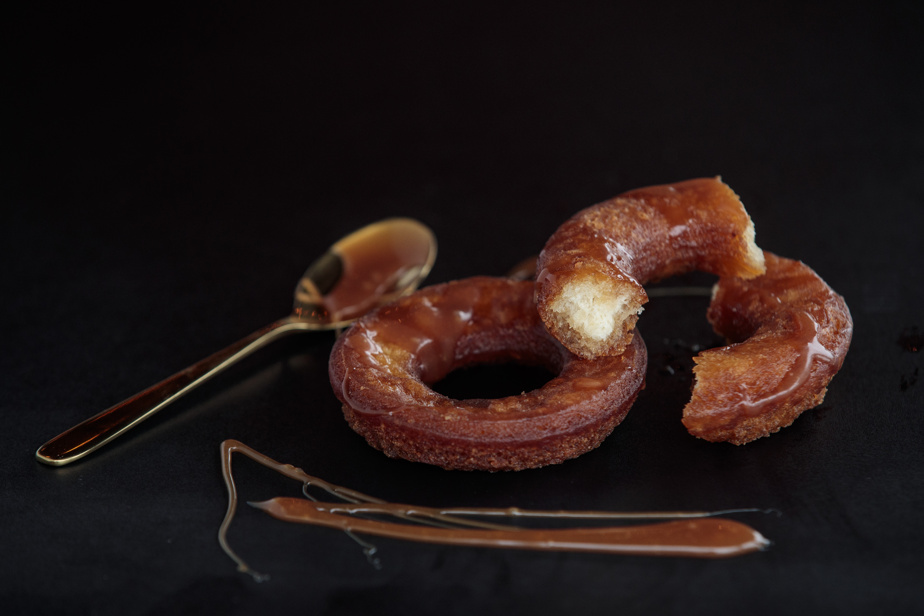
Photo Hugo-Sébastien Aubert, LA PRESSE archives
Potato and maple syrup donuts
Decadent as one might wish, donuts with potatoes and maple syrup are among Quebec’s culinary traditions. Passed down from one generation to another, each recipe has its secrets. Isabelle Plante gives us hers.
Preparation time: 30 minutes
Cooking time: 3 minutes
Servings: 15 donuts (freeze)
Ingredients
- 625 ml (2 1/2 cups) unbleached all-purpose flour
- 15 ml (1 tbsp.) baking powder
- 2.5 ml (1/2 tsp) baking soda
- 2.5 ml (1/2 tsp) salt
- 2 eggs
- 250 ml (1 cup) sugar
- 30 ml (2 tbsp.) unsalted butter, melted and tempered
- 180 ml (3/4 cup) plain russet mashed potatoes, lukewarm
- Vegetable shortening or canola oil, for frying
- 250 ml (1 cup) maple syrup
Preparation
- 1. In a bowl, combine flour, baking powder, baking soda and salt. To book.
- 2. In another bowl, beat the eggs and sugar with an electric mixer for about 1 minute or until frothy. Add butter, mashed potatoes and mix well. Add the dry ingredients and mix until the batter is smooth. Form two disks of dough with your hands. Cover with plastic wrap and refrigerate for 1 hour.
- 3. Preheat the fat or oil in the fryer to 190°C (375°F). Line a cookie sheet with paper towel. Place a wire rack on another cookie sheet. Pour the maple syrup into a bowl. To book.
- 4. On a floured work surface, roll out the dough to a thickness of 8 to 10 mm. Cut out the donuts using a 7.5 cm (3 in) round cookie cutter, then cut out the donut holes using a small 2 cm (3/4 in) round cookie cutter ). Reuse scraps. Leave to stand for 15 minutes at room temperature to allow the dough to dry slightly and form a nice crust when cooked.
- 5. Place 3 or 4 donuts at a time in the hot shortening and cook for 2 to 3 minutes or until golden brown, turning them halfway through cooking. Watch out for splashes. Drain on paper and let cool for 1 minute. Then dip the donuts, one at a time, in the maple syrup. Drain on the grill and let cool. Proceed in the same way for the donut holes (cooking them for only 1 minute).
- 6. Serve the donuts warm at room temperature.
Suggestion of accompaniment: salted caramel with sweet clover
Ingredients
- 60 ml (1/4 cup) of water
- 500 ml (2 cups) sugar
- 30 ml (2 tbsp.) colorless corn syrup
- 180 ml (3/4 cup) 35% cream, hot
- 2.5 ml (1/2 tsp) sweet clover (or vanilla) essence
- 125 ml (1/2 cup) semi-salted butter, diced
Preparation
- 1. In a saucepan, bring the water, sugar and syrup to a boil. Cook without stirring until the mixture takes on an amber color. Off the heat, gradually add the cream.
- 2. Bring to a boil again, until the mixture is homogeneous. Add the butter and mix well until melted. Add sweet clover (or vanilla). Transfer to glass jars and let cool completely at room temperature. Keeps for two weeks at room temperature or 1 month in the refrigerator.
Published on lapresse.ca on December 6, 2017.
Health ! : martini brunch
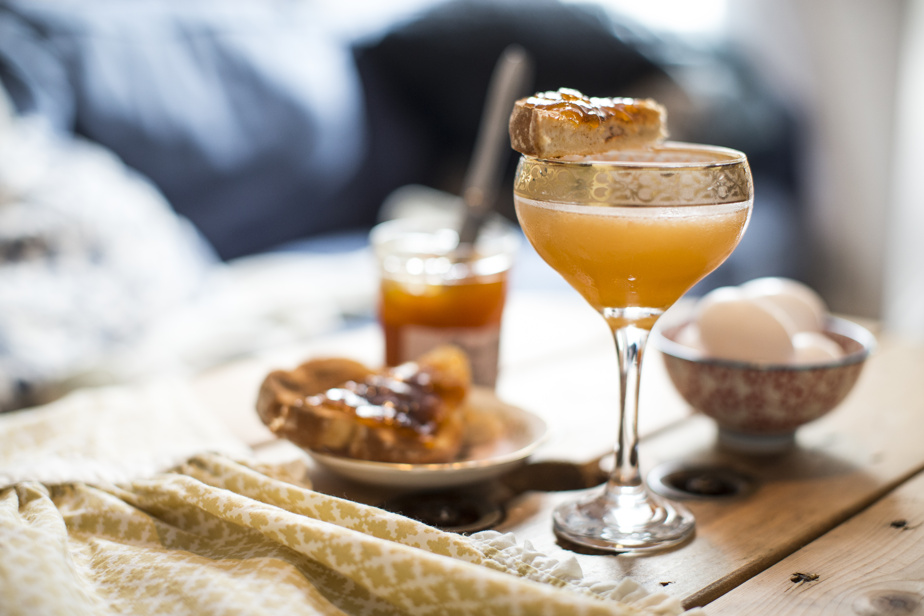
Photo OLIVIER PONTBRIAND, La Presse archives
martini brunch
Montrealers love brunch. Montrealers are (again) starting to love cocktails. Tips and recipes to add sparkle to your Sunday lunches.
Ingredients
- 1 1/2 oz (45 ml) Bombay Sapphire gin
- 1/2 oz (15 ml) St-Germain (elderflower liqueur)
- 2 tbsp. 2 tbsp (30 ml) Bonne Maman apricot jam (or any other quality yellow fruit or citrus jam)
- 1/2 oz (15 ml) white grapefruit juice
Preparation
- 1. Put the 2 tablespoons of jam in the shaker. Add the gin, St-Germain and white grapefruit juice.
- 2. Stir with a spoon to dissolve the jam.
- 3. Fill the shaker with ice and shake well for 5 to 10 seconds. Strain through a tea strainer into a chilled martini glass.
- 4. Garnish with toast spread with your favorite marmalade.
Source: recipe by mixologist Jonathan Homier.
Published on lapresse.ca on July 15, 2015.
